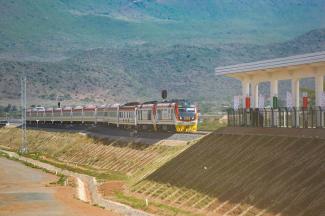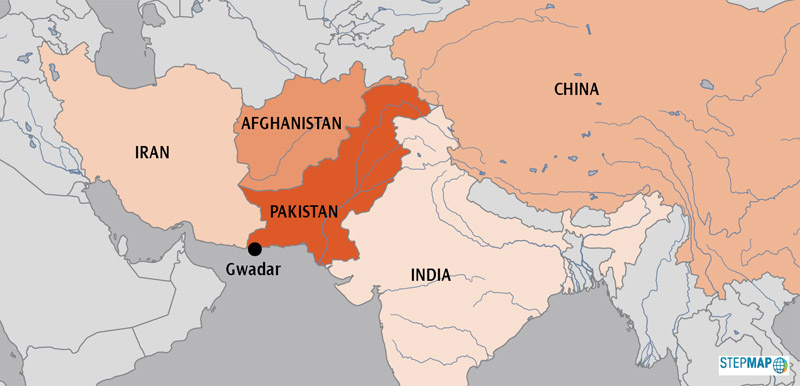Infrastructure
Railway to nowhere

Kenya’s new cross-country railway line, with its fast, modern trains and gleaming stations, is intended to showcase the country’s ambitions to create a prosperous economy under its own stewardship, free of colonialist influences. Instead the project, popularly known as “the SGR” for standard-gauge railway, has run into stiff headwinds.
This autumn, the government inaugurated a new segment of the new railway line. The 120-kilometre stretch links northwestern Nairobi to the Rift Valley town of Naivasha. The new segment extends an existing 485-kilometre SGR line between Nairobi and the port city of Mombasa, which was similarly financed by China and was opened in 2017.
The new segment was opened with great fanfare, with official speeches and ribbon-cutting. Yet celebrations were muted by a financial cloud hanging over the project: Last April China’s government said it would not finance or build the third phase of the project, which aims to connect Naivasha with Malaba on the Ugandan border, about 350 kilometres northwest of Naivasha.
Kenya’s government plans to go ahead with phase three anyway, funding a refurbishment of a portion of the old colonial-era railway with its own, much more limited funds. For now, though, the modern railway ends in Naivasha, where the government plans to build an industrial park to encourage rail freight on the new line, but so far has not done so.
The rail link ends in Naivasha – a small town with no major industrial facilities or other transport links. The gleaming new line has thus attracted the epithet “railway to nowhere”.
The current “end of the line” at Naivasha also calls into question whether an original regional masterplan that envisaged extending rail links beyond the Uganda border to Rwanda and the Democratic Republic of Congo will ever be implemented.
Engine of controversy
The truncated building plan is not the only source of controversy. Critics contend the rail line is not commercially viable. It was intended mainly as a freight route, but freight owners have so far stayed away, citing high costs of using rail compared to road transport. Kenyan firms also complain that the government is trying to force them to use the rail line even if it is not economical for them to do so.
Controversy surrounds the precise choice of route for the railway line moreover. The old railway line, which was built during British rule, the Mombasa-Nairobi section terminated in downtown Nairobi. The new Chinese-built railway terminates in Syokimau, nearly 20 kilometres southeast of the capital’s central business district. That location adds to the costs of passengers who are travelling to and from central Nairobi. It similarly affects freight-shippers.
Above all, controversy surrounds the cost of the rail line, the published details of which are sparse. Apart from Kenya’s President Uhuru Kenyatta and his senior officials few people in Kenya know the total railway’s cost and contract terms. The Chinese embassy in Nairobi, of course, is informed too.
Much of the $ 1.5 billion ( € 1.35 billion) cost of building the new stretch from Nairobi to Naivasha was funded by loans from the Chinese government. So was the estimated $ 3.2 billion cost of building the phase one track from Mombasa to Nairobi.
Those cost totals are estimates, however. The full cost and the detailed breakdowns are not publicly known. When Kenyan journalists pressed President Kenyatta for further details, he replied, “You want the contract? I will give it to you tomorrow.” However, the contract remains secret, and efforts to use Kenya’s “Access to Information” law to get it have so far been fruitless (see box).
To top it all off, critics say that corruption may have been involved in the project. In 2018 authorities arrested the chairman of the National Land Commission, as well as senior officials of the state-run railway, on suspicions over land allocation and the amount of compensation paid for railway land.
Ties that bind
None of this changes the fact that the new railway line, at least in theory, takes a much-needed step toward closing Kenya’s – and Africa’s – infrastructure gap. As a necessary part of developing productive economies, African governments must invest in infrastructure and open up large swathes of land for new roads and railways. Initiatives such as Kenya’s Vision 2030 – the country’s development programme from 2008 to 2030 – and Africa’s Agenda 2063, the African Union’s blueprint for transforming the continent, call for such large-scale projects.
Infrastructure is costly and governments with limited budgets have to borrow much of that money, hoping that the infrastructure will promote job-generating investment. In the words of Transport Minister James Macharia, “we need to be positive and patriotic”.
Despite all the criticisms of the SGR project, the fact remains that passengers can now travel from Mombasa to Nairobi in four hours, half the time it took before. Freight travels from Mombasa to Nairobi in about the same time. President Kenyatta points out that, over 100 years after British colonialists built the old metre-gauge railway, a new modern one is taking shape, this time under Kenyan management and control.
Advocates also say that completing the cross-country line in Kenya will open new vistas for external trade. The original region-wide masterplan in 2007 envisioned a long railway line extending from Mombasa via Nairobi to Uganda and then onwards in a southwesterly direction to Rwanda and the Democratic Republic of Congo. Another line was intended to link Kenya with South Sudan to the north. “The SGR project will not be completed until we get to those countries,” Transport Minister Macharia said.
Officials point to ample evidence that new infrastructure will drive commerce and industry, even if a new line is not profitable on its own in the near term. Kenya’s developed areas tend to be within 100 miles on either side of the old metre-gauge railway. Officials say that a new railway will spur development along its route.
Certainly, such investments are not always profitable, at least in terms of the returns made by the infrastructure itself. One example is the Tanzania-Zambia railway, a decades-old 1,860-km Chinese-built railway between Dar es Salaam in Tanzania and New Kapiri Mposhi in Zambia. The Tanzania-Zambia Railway Authority received a financial boost from its government owners in October, after consistently failing to make a profit.
Critics of Kenya’s SGR argue that the Tanzania-Zambia Railway’s lack of profitability should serve as a warning about building a white elephant in Kenya. The debate continues in Kenya both over the commercial viability of the SGR itself – the parts completed so far and the part yet to be built – and over the line’s multiplier effects on economic growth in general.
There may be no precise answers to be found now to either question. But more government openness about the project’s finances and its terms and conditions would inspire more confidence.
Alphonce Shiundu is a Kenyan journalist, editor and fact-checker based in Nairobi.
Twitter: @Shiundu













